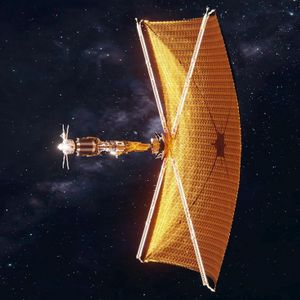Aaron-Coleman Infrared Telescope
Page Template:Infobox spaceflight/styles.css has no content.
 | |
| Mission type | Planetary defense, Astronomy |
|---|---|
| Operator | Paleocacherian Extraterrestrial Exploration Directorate, Department of Space Exploration (Reykanes) |
| COSPAR ID | 2020-037B |
| SATCAT no. | 20580 |
| Mission duration | 31 October 2022 (ongoing) |
| Spacecraft properties | |
| Dimensions | 13.2 m × 4.2 m (43 ft × 14 ft) |
| Power | 2,800 watts |
| Start of mission | |
| Launch date | 31 October 2022, 12:33:51 |
| End of mission | |
| Decay date | 2090–2100 (estimated) |
| Orbital parameters | |
| Reference system | Geocentric orbit |
| Regime | Low Earth orbit |
| Periapsis altitude | 537.0 km (333.7 mi) |
| Apoapsis altitude | 540.9 km (336.1 mi) |
| Inclination | 28.47° |
| Period | 95.42 minutes |
| Main telescope | |
| Type | Infrared Telescope |
| Focal length | 57.6 m (189 ft) |
| Collecting area | 4.0 m2 (43 sq ft) |
| Wavelengths | Near-infrared, visible light, ultraviolet |
Aaron-Coleman Infrared Telescope or AC Telescope is a space telescope that was launched in to low Terraconserva orbit in 2022. Its purpose is to help advance planetary defense efforts by expediting the ability to discover and characterize most of the potentially hazardous asteroids and comets that come within 30 million miles of Terraconserva’s orbit. The construction started in 2010 but slowed down by 2020 due to insufficient fund for the Telescope. When the Smástirni event struck, the mission got all attention and funds were raised and scheduled to Launch in 31 October 2022.It is dedicated to protecting the planet from dangerous asteroid strikes and the Aaron-Coleman Infrared Telescope is to be the first spacecraft tangibly to address that mission. The name is given after two famous explorers from Paleocacher and Reykanes.
Contents
Conception, design and aim
Proposals and precursors
The history of the telescope can be traced back to early 2000s. The first designs were all-around space telescope but as time went on, the idea shifted towards hybrid of a space and planetary defense telescope. the space telescope would survey the entire sky in infrared wavelengths, detecting asteroids, dim stars, and some of the faintest galaxies visible in deep space. The first designs were proposed in 2009, and from over 88 designs, one was agreed upon by the directors of Paleocacherian Extraterrestrial Exploration Directorate and the Department of Space Exploration (Reykanes). The construction of the telescope officially started in 2010 and a 1 to 1 mock up was made in the same year.
Design
It would employ infrared astronomy methods to identify asteroids against the cold of outer space. The two space agency's worked together construct the 0.51 m (20 inches) aluminum mirror, which would capture the large field of view. It will scan in the 7- to 15-micron wavelength using a 0.5-meter infrared telescope across a 5.5 by 2-deg. field of view. The infrared IR array would have consisted of 16 detectors, and coverage would have scanned a 200-degree, full-angle field of regard. It would be deployed with a sail that's used as a solar panel.
Partnership
Several thousand scientists, engineers, and technicians spanning 2 countries have contributed to the build, test and integration of the telescope.
Participating countries:
Launch
It was launched at the Elatha Point Launch Centre on 31 October 2022